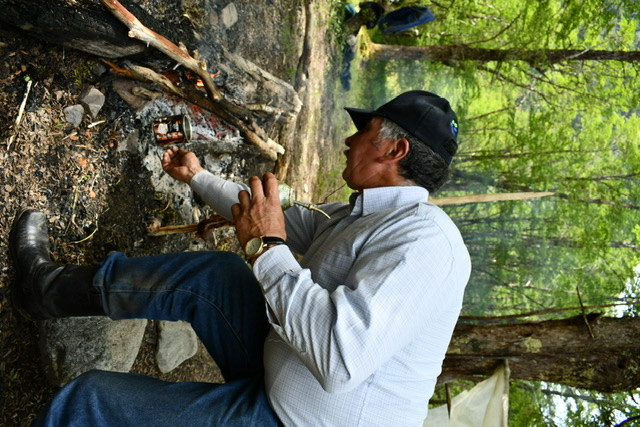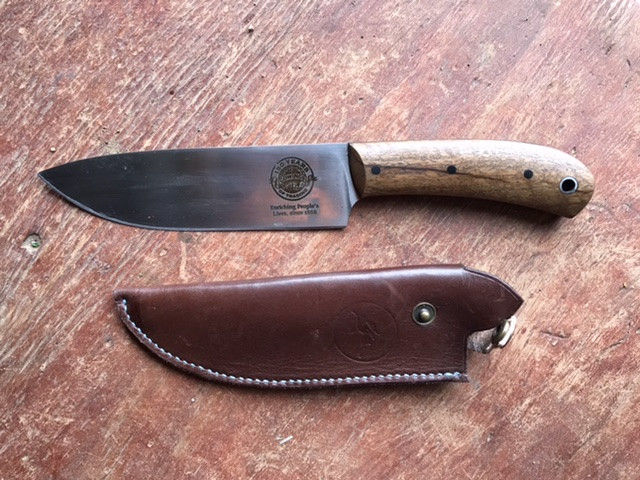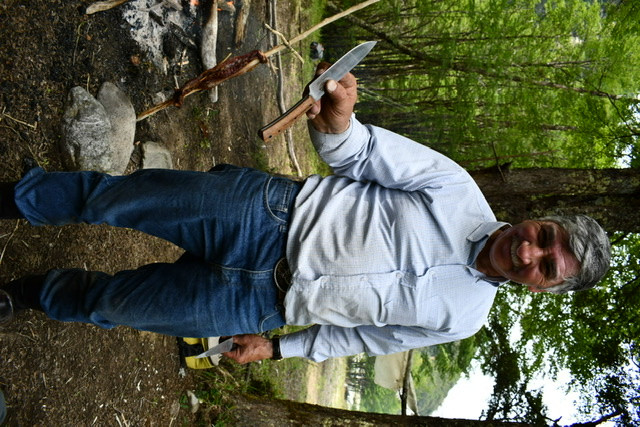Mate and Sharp Steel

Alfredo the huaso (a term like our US cowboy) had made the asado cross from green sticks so they would not burn while exposed to the heat of the fire. The coals were banked high and the beef was pitted and roasting. As we sat around the fire watching the process Alfredo offered us mate. I think he was truly surprised when we accepted the mate cup.
Mate (pronounced “maa-tay”) is a bitter green herb drank like a tea. It’s extremely popular in the southern South American countries. A lot of gringos describe mate tasting like old, wet hay. For some odd reason, perhaps it’s because we wish to absorb every aspect of our experiences here, we enjoy mate. More so in Argentina then in Chile, it is common for persons to stop what they’re doing throughout the day and gather to share the mate. It’s a pleasant reminder of how these cultures value the company of family and friends. The British take their tea, the Italians take their espresso, in the United States we take a coffee break and Argentinians and Chileans take mate.

The common way to serve mate is within a hollow vessel-cup sized to fit the palm of a hand. Squash gourds and carved wood are the most common mate vessels. They are often adorned with silver rims and/or feet to stand them on a level surface. A silver straw with a bulbous, perforated end called a bombilla (“bomb-bee-sh-ya”) is placed into the cup and the dry mate leaves are introduced into it.

Boiling water is slowly poured into the cup. Alfredo, on this day, boiled his water in an old can modified with wire and filled with water taken from the nearby river. It is sacrilegious to the mate process to disturb the bombilla after the first introduction of water. The mate is then passed from person to person. Each person, in turn, drains the cup by sipping and passes it back to the host of the mate. The host then refills the cup with hot water and passes it to the next person, and so-on, until every person who is fulfilled tells the host “Gracias” (“thank you”) meaning they are finished and have had enough.

Alfredo’s sense of humor showed in his choice of a personal mate cup: under its glossy, shellacked surface was an inscription that read ”de las gracias” (“just say thank you”) meaning roughly “be done already”.
After putting the mate aside, Alfredo tucked his bombilla into the knife holster at his back-belt line, an accessory consistent among all gauchos, and produced his knife, which he began sharpening in anticipation of serving the asado.
Knives, sharp knives, are an important aspect in the cultural identity of this part of the world. We in the United States are content to buy shitty, cheap knives sporting plastic handles, stamped stainless steel blades and serrated edges at Walmart. We then toss them into drawers with the rest of the kitchen utensils then throw them away when they stop cutting. Sometimes we don’t throw them away and keep using the dull, dangerous pieces of shit. Few North Americans who own quality knives know how to sharpen then properly. The Argentinians and Chileans, on the other hand, pride themselves on owning quality steel knives and knowing how to sharpen them. Stainless steel is an anathema to the purist, who seek out the finest carbon steel blades of kitchen knives manufactured in Solingen, Germany between the World Wars. This affinity to the knife is tied directly to the gaucho culture, a foundational aspect of regional identity much like the frontiersman ethic we feel closely tied to in North America.

As I watched Alfredo carefully sharpening his two knives, one of which was getting worn extremely narrow from years of care, it occurred to me to ask him to sharpen mine.
Knowing of the knife culture from several previous trips to Argentina, I made sure Lynnette and I both had personal knives in the event we were invited to an asado. Personal asado kits, including knife, fork, and a wooden plate wrapped in a leather holster, are offered for sale in artisanal gift shops everywhere in this region. I’ve also noticed beautiful knives, waiting for resident and absent family members, sitting on side boards of dining rooms in person‘s personal homes we’ve entered. I figured it was just good form, but every time we produce our own knives our hosts are actually surprised.

This past year at the lodge in Alaska, I had been given a beautiful knife as a surprise gift from an Australian couple, who explained their family had been manufacturing them since 1868. It took me back to get such a beautiful knife, and it came to me very sharp, yet, I really wanted to see what Alfredo could do with it. I offered it to him with a translated request to please do the honor of showing how sharp he could make it.

Alfredo produced a tiny piece of whetstone, apologized for its diminutive size with a twinkle in his eyes, then began working the edges of my knife. He carefully ground at an angle shallower than I was accustomed to doing myself; perhaps about 33°. When he had finished both sides of my blade he took his extremely worn knife and, in a flurry of motion I wouldn’t recommend anybody attempt without careful training, ran both steel blades against one other alternating left and right sides of each knife blade several times. He then presented my knife for me to test the results. It was sharp as a razor blade. Meat, when pressed-upon by the blade with the slighted motion, separated like soft butter.
This knife, which had now passed across the equator twice to the extreme ends of the earth, was now an culturally authentic (criollo) accessory to this criollo Patagonian experience.
